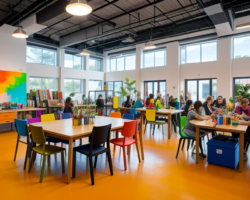Creating a Fun and Engaging Environment
Creating a Fun and Engaging Environment for workshops or activities is crucial to ensuring that participants remain motivated and focused. Whether you are organizing a team-building event, a classroom session, or a training workshop, a fun and engaging environment can make a significant difference in the overall experience.
One way to create a fun and engaging environment is by incorporating interactive games and activities. These activities not only break the ice but also encourage participants to actively participate and collaborate with others. For instance, you can organize group challenges or scavenger hunts that require participants to work together towards a common goal. Such activities not only promote teamwork but also make the learning process enjoyable.
In addition to activities, it is important to choose a suitable venue or setting. A colorful and well-decorated space can instantly create a positive and lively atmosphere. Consider using vibrant posters, banners, and props related to the theme of your workshop. Moreover, make sure the venue is spacious enough to accommodate all participants comfortably and allows for easy movement during activities.
Furthermore, providing a variety of materials and resources can enhance engagement levels. Whether it’s arts and crafts supplies, multimedia presentations, or hands-on learning tools, having diverse materials can cater to different learning styles and preferences. This ensures that participants remain actively involved throughout the workshop and helps keep their interest and enthusiasm levels high.
- Organize interactive games and activities
- Choose a suitable venue and decorate it
- Provide a variety of materials and resources
| Key Points: |
|---|
| Interactive games and activities promote engagement and teamwork. |
| A well-decorated venue creates a positive and lively atmosphere. |
| Providing diverse materials caters to different learning styles. |
Choosing Age-Appropriate Activities
When planning any activity or workshop for children, one of the key factors to consider is choosing age-appropriate activities. It is essential to choose activities that align with the children’s developmental milestones, interests, and abilities. By selecting activities that cater to their age group, you can ensure that they are engaged, challenged, and have a positive learning experience.
One way to determine age-appropriate activities is to consider the cognitive, physical, and emotional development of the children. For younger children, activities that focus on sensory exploration and fine motor skills can be appropriate. These could include finger painting, playdough activities, or sorting objects by color or shape. On the other hand, older children might benefit from more complex activities that involve problem-solving, critical thinking, or teamwork.
In addition to considering the developmental aspects, it is important to take into account the children’s interests and preferences. By incorporating their interests into the activities, you can create a more engaging and enjoyable learning experience. Whether it’s sports, arts and crafts, music, or science experiments, tailoring the activities to their interests can spark curiosity and motivation.
- Engagement: Choosing age-appropriate activities helps to keep the children engaged throughout the workshop. When the activities are tailored to their interests and abilities, they are more likely to remain focused and enthusiastic.
- Learning: Age-appropriate activities provide an optimal level of challenge for the children, allowing them to learn new skills and knowledge. When the activities are neither too easy nor too difficult, it promotes their cognitive and physical development.
- Enjoyment: By choosing activities that align with their interests, children are more likely to enjoy the workshop. When they are having fun, they become more receptive to learning and actively participate in the activities.
| Age Group | Sample Activities |
|---|---|
| 2-3 years | Finger painting, building blocks, coloring |
| 4-6 years | Simple science experiments, storytelling, music and movement |
| 7-9 years | Team sports, arts and crafts projects, basic coding activities |
| 10-12 years | Advanced science experiments, DIY projects, writing workshops |
Ultimately, choosing age-appropriate activities contributes to a more meaningful and effective learning experience for children. It allows them to explore their capabilities, develop new skills, and have fun in a safe and engaging environment. By carefully selecting activities that cater to their age group and interests, you can ensure the workshop is enjoyable, educational, and beneficial for the children.
Setting Clear Goals and Objectives
Setting clear goals and objectives is essential for any successful workshop or learning environment. Without clear goals, participants may feel lost or unsure of what they are working towards. Clear objectives provide a roadmap for both the facilitator and the participants, guiding them in the right direction and helping them stay focused on the desired outcomes.
When setting goals and objectives, it is important to make them specific and measurable. Vague or abstract goals can be confusing and make it difficult to assess progress. Instead, clearly define what you want to achieve and how you will measure success. For example, if you are conducting a team-building workshop, a specific goal could be “to improve teamwork and collaboration skills” and the objective could be “for participants to successfully complete a team project and demonstrate effective communication.”
Another important aspect of setting goals and objectives is ensuring they are achievable and realistic. Setting unrealistic goals can lead to frustration and disappointment if they are not met. Consider the abilities and limitations of your participants and tailor the goals accordingly. It is better to set smaller, attainable goals that can be built upon rather than overwhelming participants with unrealistic expectations.
Providing Clear Instructions and Demonstrations
When organizing a workshop or any kind of educational activity, it is crucial to provide clear instructions and demonstrations to ensure that participants understand the objectives and know how to effectively engage in the activity. Clear instructions and demonstrations not only help participants to grasp the concept but also foster a sense of confidence and independence in their learning process.
One effective way to provide clear instructions is to break down complex concepts into simple and easy-to-understand steps. This can be achieved by using visual aids such as diagrams, charts, or even videos. Visual representations help participants to visualize the process or task at hand and make it easier for them to digest the information. Additionally, it is important to use plain and concise language when delivering instructions, avoiding any jargon or technical terms that might confuse or overwhelm participants.
Furthermore, demonstrations play a vital role in illustrating how to perform a particular task or activity. By watching someone else do it, participants can better understand the procedure and gain valuable insights. It is important to ensure that demonstrations are conducted in a clear and organized manner, highlighting key steps and important details. This can be done through verbal explanations, pointing out important features, or even providing additional tips and tricks to ensure participants have a comprehensive understanding.
In conclusion, providing clear instructions and demonstrations is essential for a successful workshop or educational activity. By breaking down complex concepts, using visual aids, and conducting well-organized demonstrations, participants will be equipped with the necessary knowledge and skills to actively engage in the activity. The clarity and effectiveness of these instructions and demonstrations will ultimately contribute to a more productive and meaningful learning experience.
Encouraging Active Participation and Collaboration
Encouraging active participation and collaboration in any setting is essential for creating an engaging and interactive environment. When individuals actively participate in an activity or discussion, they are more likely to be fully engaged and invested in the learning process. This not only enhances their understanding and retention of information, but it also fosters a sense of ownership and empowerment.
One effective way to encourage active participation is by incorporating hands-on activities and interactive exercises. These activities can be tailored to the specific topic or goal of the workshop, allowing participants to apply their knowledge and skills in a practical manner. By providing opportunities for individuals to actively engage with the material, you are promoting critical thinking and problem-solving abilities.
Collaboration is another key aspect of fostering an active learning environment. Encouraging participants to work together in pairs or small groups helps to build teamwork and communication skills. It also allows individuals to benefit from different perspectives and insights, as they can learn from one another’s experiences and knowledge.
- Active participation promotes engagement and understanding.
- Hands-on activities encourage practical application of knowledge.
- Collaboration fosters teamwork and communication skills.
| Benefits of Active Participation and Collaboration: |
|---|
| 1. Enhanced Learning: When individuals actively participate, they have a more immersive learning experience, leading to better understanding and retention of information. |
| 2. Critical Thinking Skills: Engaging in hands-on activities stimulates critical thinking, problem-solving, and decision-making abilities. |
| 3. Empowerment and Ownership: Active participation gives individuals a sense of ownership and empowerment over their learning journey. |
| 4. Collaboration and Communication: Working together in groups fosters teamwork, effective communication, and the exchange of diverse perspectives. |
Offering Positive Reinforcement and Feedback
When it comes to teaching and instruction, positive reinforcement and feedback play a crucial role in enhancing learning and motivating learners. Offering positive reinforcement and feedback not only boosts self-esteem and confidence but also encourages active participation and collaboration among learners. It creates a supportive and encouraging environment where learners feel valued and motivated to achieve their goals. Additionally, feedback allows learners to understand their strengths and areas for improvement, helping them to enhance their skills and knowledge.
One effective way to offer positive reinforcement is through verbal praise. By acknowledging and appreciating learners’ efforts, progress, and achievements, instructors can boost their confidence and enthusiasm. For example, saying phrases like “Great job!” or “Well done!” can go a long way in providing encouragement and making learners feel appreciated. In addition to verbal praise, instructors can also use non-verbal cues, such as a thumbs-up or a smile, to acknowledge learners’ contributions and efforts.
Feedback is an essential component of the learning process as it helps learners understand their strengths and areas for improvement. Constructive feedback should be specific, actionable, and focused on the task or skill at hand. By providing detailed feedback, instructors can guide learners on their learning journey and support their growth. For instance, instead of simply saying, “Good job,” instructors can provide specific feedback such as, “I like how you organized your ideas in this paragraph. Your writing is clear and coherent.” This not only highlights the learner’s strengths but also provides guidance for improvement.
- Positive reinforcement enhances confidence and motivation
- Verbal praise and non-verbal cues are effective methods of positive reinforcement
- Constructive feedback helps learners understand their strengths and areas for improvement
- Feedback should be specific, actionable, and focused on the task or skill
| Benefits of Positive Reinforcement and Feedback | Methods of Positive Reinforcement |
|---|---|
| 1. Boosts self-esteem and confidence | 1. Verbal praise |
| 2. Encourages active participation and collaboration | 2. Non-verbal cues |
| 3. Creates a supportive and encouraging environment | |
| 4. Helps learners understand their strengths and areas for improvement |
Overall, offering positive reinforcement and feedback is essential for creating an engaging and supportive learning environment. By utilizing verbal praise, non-verbal cues, and constructive feedback, instructors can empower learners, enhance their confidence, and foster a collaborative learning culture. It is through these methods that learners can feel motivated, engaged, and inspired to achieve their learning goals.
Ensuring Safety and Supervision during the Workshop
When conducting a workshop, the safety and well-being of participants should be the top priority. Creating a safe and supervised environment is essential to prevent accidents and injuries. Here are some key strategies to ensure safety and supervision during the workshop:
1. Designate a Safety Officer: Assign someone to take responsibility for monitoring safety procedures throughout the workshop. This person should have knowledge of safety protocols and be able to handle emergency situations effectively.
2. Perform Risk Assessments: Before the workshop begins, conduct a thorough risk assessment of the venue. Identify potential hazards such as loose wires, unstable equipment, or cluttered areas. Take necessary measures to eliminate or minimize these risks.
3. Provide Safety Guidelines: Clearly communicate safety rules and guidelines to all participants at the start of the workshop. Emphasize the importance of following these guidelines to ensure a safe environment for everyone involved.
| List of Safety Rules: |
|---|
| 1. Always wear appropriate safety gear, such as goggles or gloves, when necessary. |
| 2. Keep workstations clean and organized to prevent accidents and tripping hazards. |
| 3. Report any equipment malfunctions or potential dangers immediately. |
| 4. Follow the instructions and demonstrations provided by the facilitators. |
| 5. Use tools and materials only for their intended purpose. |
4. Train Staff and Volunteers: If there are staff members or volunteers assisting with the workshop, ensure they receive proper training on safety protocols. They should be knowledgeable about emergency procedures and how to handle different situations that may arise.
5. Implement Emergency Response Plan: Develop an emergency response plan and share it with all participants. Conduct drills or simulations to familiarize everyone with the procedures to follow in case of emergencies such as fires, accidents, or medical incidents.
By implementing these safety measures, workshop organizers can create an environment that promotes learning while also prioritizing the well-being of all participants. Remember, accidents can happen anywhere, but with careful planning and supervision, they can be minimized or avoided altogether.
Frequently Asked Questions
Question 1: How can I create a fun and engaging environment for a workshop?
Answer: To create a fun and engaging environment for a workshop, you can incorporate interactive activities, games, and group exercises that encourage participation and collaboration among participants. You can also use visual aids, props, and technology to make the workshop more interactive and exciting.
Question 2: How do I choose age-appropriate activities for a workshop?
Answer: When choosing age-appropriate activities for a workshop, consider the participants’ developmental level and interests. Research and understand the age group you are targeting, and select activities that match their abilities and preferences. It’s also essential to consider any safety concerns or restrictions based on age.
Question 3: Why is it important to set clear goals and objectives for a workshop?
Answer: Setting clear goals and objectives for a workshop provides a sense of direction and purpose. It helps participants understand what they can expect to learn or achieve during the workshop. Clear goals and objectives also allow for focused planning and ensure that the workshop stays on track.
Question 4: How can I provide clear instructions and demonstrations during a workshop?
Answer: To provide clear instructions and demonstrations during a workshop, use simple and concise language, and avoid jargon or technical terms that may confuse participants. Provide step-by-step demonstrations whenever necessary, and encourage participants to ask questions and seek clarification to ensure understanding.
Question 5: How can I encourage active participation and collaboration in a workshop?
Answer: Encouraging active participation and collaboration in a workshop can be achieved by creating a safe and inclusive environment where everyone feels comfortable contributing their ideas and opinions. Incorporate interactive activities that require group work and discussion, and provide opportunities for participants to share their thoughts and insights.
Question 6: Why is offering positive reinforcement and feedback important during a workshop?
Answer: Offering positive reinforcement and feedback during a workshop helps to motivate participants and boost their confidence. It acknowledges their efforts and progress, making them more likely to actively engage in the workshop. Positive reinforcement also fosters a positive learning environment and encourages participants to continue learning and improving.
Question 7: How can I ensure safety and supervision during a workshop?
Answer: To ensure safety and supervision during a workshop, always conduct a risk assessment before the event and implement necessary precautions. Have trained staff or volunteers available to monitor participants and address any safety concerns. Clearly communicate safety rules and guidelines to participants and establish emergency procedures if needed.





